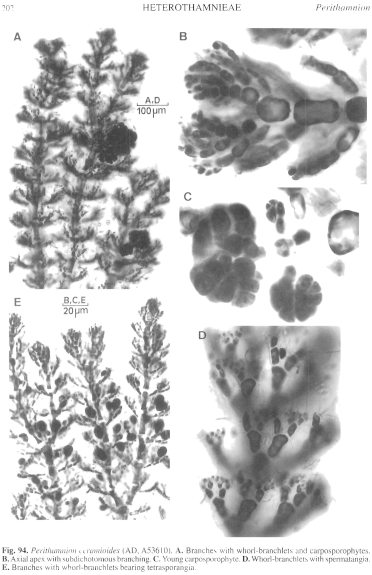|
|
|
|
|
|||||||||||
|
Electronic Flora of South Australia Species Fact Sheet
Phylum Rhodophyta – Order Ceramiales – Family Ceramiaceae – Tribe Heterothamnieae
Selected citations: Athanasiadis 1996: 176, figs 85, 86.
Thallus (Fig. 94A) 2–6 cm high, much branched with several erect subdichotomous axes bearing lateral branches from lower and central parts of the thallus, few from upper parts, each axial cell with 4 similar whorl-branchlets (Fig. 94A, E); main lateral branches arising apically (Fig. 94B) and becoming subdi- (or tri-) chotomous, with the upper axial cells pit-connected above the whorl of 4 whorl-branchlets, with laterals also from basal cells of whorl-branchlets to form shorter lateral branches. Attachment by rhizoids from basal cells of axes; epiphytic on other taxa than Cystophora. Structure. Apical cells 4–6 µm in diameter and L/D 1–1.5, enlarging rapidly to thick walled axial cells 30–60 µm in diameter and L/D 1.4–2.2 in mid axes and 150–250 µm in diameter and L/D 0.6–1 in lower axes,. Whorl-branchlets more or less complanately branched and slightly upwardly curved, usually closely adjacent, 50–110 µm long, branched from the basal cell with several successive subdichotomies and sometimes a terminal chain of 2–3 cells; basal cells of whorl-branchlets (10–) 14–20 (–25) µm in diameter and L/D 1.2–1.7 (–2), tapering to terminal cells 5–9 µm in diameter and L/D 1–1.5 (–2); gland cells prominent on the terminal and subterminal cells of whorl-branchlets, hemispherical to ovoid, touching only the bearing cell or abutting the next upper cell, 6–10 µm in diameter. Cells uninucleate; rhodoplasts discoid in small cells, becoming ribbon like in axial cells.
Reproduction: Gametophytes dioecious (or monoecious?). Carpogonial branches borne near the apices of short lateral branches, on the basal cells of short whorl-branchlets. Post-fertilization a terminal rounded gonimolobe (Fig. 94A, C) 90–140 µm across develops, with ovoid carposporangia 15–20 µm across, often with 1–2 lateral gonimolobes; basal procarp cells usually fuse. The carposporophytes occur laterally along the axes, usually without involucral branchlets. Spermatangia (Fig. 94D) cut off terminally from terminal cells of whorl-branchlets, sparse, ovoid, 2–3 µm in diameter.
Tetrasporangia (Fig. 94E) occur on mid cells of whorl-branchlets, lying above the whorl-branchlet, sessile, subspherical, 25–40 µm in diameter, tetrahedrally divided.
Type from Spring Creek, Port Phillip Heads, Vic. (Wilson); holotype in Herb. Agardh, LD, 18201. Spring Creek enters the sea at Torquay, some 40 km W of Port Phillip Heads.
Selected specimens: Cockburn Sound, W. Aust., on Posidonia (Allender, 22.viii.1966; AD, A30703). Vivonne Bay, Kangaroo I., S. Aust., on Macrothamnion secundum, lower eulittoral on reef (Wollaston, 30.i.1956; AD, A67124). Waratah Bay, Vic., on Cladostephus spongiosus, uppermost sublittoral (Sinkora A2422, 3.iii.1978; AD, A53610).
Distribution: Cockburn Sound, W. Aust., to Waratah Bay, Victoria.
Taxonomic notes: P. ceramioides is superficially similar to Elisiella arbuscula but the latter differs in dimensions, in lack of near apical subdichotomous branching, and it occurs mainly on species of Cystophora, whereas P. ceramioides is known on other taxa than Cystophora.
Athanasiadis (1996, p. 175, fig. 86A) considered the spermatangia to be terminal on extended divisions of whorl-branchlet terminal cells. While his fig. 86A is unconvincing, since the supposed spermatangia are 5–5.5 µm in diameter (corresponding to smaller terminal cells of the vegetative short-branchlets), similar but smaller terminal spermatangia have been observed in AD, A53610 (Fig. 94D). However, further studies on male thalli of P. ceramioides are needed, since such terminal spermatangia are very few in number.
References:
AGARDH, J.G. (1892). Analecta Algologica. Acta Univ. lund. 28, 1–182, Plates 1–3.
ATHANASIADIS, A. (1996). Morphology and classification of the Ceramioideae (Rhodophyta) based on phylogenetic principles. Opera Botanica No. 128, pp. 1–216.
The Marine Benthic Flora of Southern Australia Part IIIC complete list of references.
Publication:
Womersley, H.B.S. (24 December, 1998)
The Marine Benthic Flora of Southern Australia
Rhodophyta. Part IIIC. Ceramiales – Ceramiaceae, Dasyaceae
©State Herbarium of South Australia, Government of South Australia
Illustration in Womersley Part IIIA, 1998: FIG. 94.

Figure 94 enlarge
Fig. 94. Perithamnion certunioides (AD, A53610). A. Branches with whorl-branchlets and carposporophytes. B. Axial apex with subdichotomous branching. C. Young carposporophyte. D. Whorl-branchlets with spermatangia. E. Branches with whorl-branchlets bearing tetrasporangia.

|
Email Contact: State Herbarium of South Australia |

|